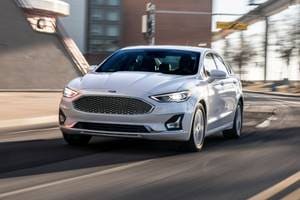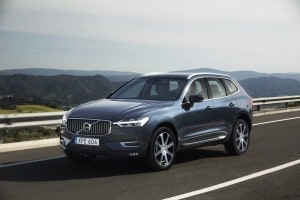Drive by Numbers - From the 2012 Beijing Auto Show
 If I could describe the Beijing Auto Show in one word, it would be chaos. Pure and utter chaos. Officially called Auto China 2012, it is the one big annual auto show in the world's largest car market. The show is crowded, lacks air-conditioning, and has press conferences going on at the same time and often near each other, so it's a struggle to hear anything. And when I say crowded, that's putting it mildly. So, why would anyone torture themselves to go to this thing? Well, it's China. The growth potential here is ginormous. China is a sleeping giant that some experts forecast can hit an annual sales rate of 75M vehicles by 2030. That number really marginalizes the U.S. struggle to get back to 16M per year this decade.
If I could describe the Beijing Auto Show in one word, it would be chaos. Pure and utter chaos. Officially called Auto China 2012, it is the one big annual auto show in the world's largest car market. The show is crowded, lacks air-conditioning, and has press conferences going on at the same time and often near each other, so it's a struggle to hear anything. And when I say crowded, that's putting it mildly. So, why would anyone torture themselves to go to this thing? Well, it's China. The growth potential here is ginormous. China is a sleeping giant that some experts forecast can hit an annual sales rate of 75M vehicles by 2030. That number really marginalizes the U.S. struggle to get back to 16M per year this decade.
The Chinese market is a complex place. I saw a Lamborghini and Ferrari race each other on the streets of Beijing (in a traffic jam, no less), yet the country's best-selling vehicle is a Wuling Sunshine, a commercial microvan that sells for less than $5,000. To understand the importance of the show with all its chaos, one has to understand the market, which is convoluted yet filled with so much opportunity. And for the automakers showing off their latest and greatest at the show, a foot in China means just about everything.
1.3B
Back in the day, a majority of China's car market was purchased and used by the government. Of course, that has all changed as China's growth has exploded and there is a middle class of folks who can afford to own cars. In fact, I was quite surprised at the lack of bikes on the streets of Beijing, but there was no end of cars. Moving forward, the sales growth in China is not so much in the major cities like Beijing and Shanghai, it's in the smaller cities — markets referred to by analysts as Tier 2, Tier 3, Tier 4 cities. What's even more surprising is just how large they are.
Shijiazhuang is considered a Tier 3 city. A Tier 3 doesn't sound impressive, right? Well, 10 million people live there. Its population is 2 million more than New York City, the largest car market in the U.S.. And I'm willing to wager that most people reading this (including me) have never even heard of Shijiazhuang, nor could we locate it on a map. That's the thing about China; there are several places like Shijiazhuang. Some are smaller and some are larger, but what's there is millions of potential car buyers. And repeat buyers.
Another growth potential is financing. The majority of consumers in China pay for the cars in cash, which is a novel concept to most Americans. Financing is, however, a growing trend among Chinese consumers. A Buick dealer in Beijing I spoke to said that he financed 10% of vehicles last year, but this year he's averaging 20%. Compare this number to the more than 50% of Americans who financed their vehicles in 2012. And then there is leasing, which isn't even on the table yet.

240,000
Of all the Beijing citizens attending the show, very few will have an opportunity to purchase a new car this year. It's not because of lack of funding or that they don't want to; it's because Beijing has a system in place which limits the number of new vehicles that can be purchased. Due to the congestion and pollution, Beijing instituted a new license plate lottery in the beginning of 2011. Each year 240,000 Beijing residents are bestowed the privilege of receiving a license plate. Car-buying hopefuls enter their name in the lottery, and once a month a drawing is held to see who the lucky few are. 240K may sound like a big number, but in a city with 20M inhabitants, it only works out to 1% of the population. So what happens if you don't get a plate? You don't drive and hope you win next month.
Luckily for dealers, there are people who already have plates that can be return customers, so loyalty is very important. Shanghai has a license plate system, too, albeit different but still aimed to reduce congestion and pollution. With all these rules in the big cites it's no wonder there is an emphasis on the growth in smaller cities where there are no license plate restrictions. This market evolution needs to take place in order to sustain the incredible growth in the auto sector.

39%
The potential for luxury sales is huge in China. The luxury market witnessed a 39% increase in 2011 and as you can imagine, this market was a big focus of the show. Brand is very important to the Chinese consumer and you can see it everywhere. In fact, I felt slightly out of place not carrying a Gucci messenger bag or a Louis Vuitton tote — I was slumming it with my lowly Longchamp travel carryall. But, I digress. Premium cars make up about 8% of the Chinese market, which is only slightly less than what we see here in the U.S. There are heavy taxes on luxury vehicles so what we pay here is a fraction of what the Chinese consumer pays for the same car. An oil and gas heiress told me quite flippantly that her family's Rolls-Royce cost four times as much in China as the same one they have back in the United States. I'm not sure if that's a scientific statement, but you probably get the idea.

What other numbers piqued my interest?
£80,000: The cost of the Victoria Beckham Land Rover Evoque Haters can hate, but the car has it all for the Chinese market: the foreign premium nameplate, the flash, the size, and the celebrity endorsement. Only 200 of these vehicles are slated to be produced, with the first batch going to China. I expect they are already sold.

1,125: The number of vehicles on display at Auto China 2012. This is up 421% from when the show opened 22 year ago.
13: The number of children I spotted walking the show floor on the first day of the media preview in the 2:00-3:00 hour. Apparently, media preview at the Beijing show means media plus whoever else is interested in going.

180: The Beijing Air Quality Index (AQI) on the first media day. This is considered "Unhealthy" and described as "Everyone may begin to experience health effects." I shouldn't complain. I checked it again while writing this article and it's at 233. This is considered "Very Unhealthy" and described as "Health warning of emergency conditions. The entire population is more likely to be affected." Yowza!

∞ The number of dragon special-edition vehicles at the show. As a number person, I would have loved to give you the final tally but I lost count somewhere along the way. They all seemed to have blended together. This is the only one that stands out in my memory.

1: The number of new Cadillac models to be introduced in China per year through 2016. Now is the time for luxury. Perhaps they can get a Zhang Ziyi edition?
Phew! Are you tired? I know I am.
Do you like numbers, too? If so, check out our Industry Data Center Jessica Caldwell is the Senior Director of Pricing & Industry Analysis for Edmunds.com. Follow @jessrcaldwell on Twitter.





